The Role of Nanosized Gold Particles in Adsorption and Oxidation of Carbon Monoxide over Au@Fe2O3 Ca
合成不同粒径大小的金纳米粒子的分析研究
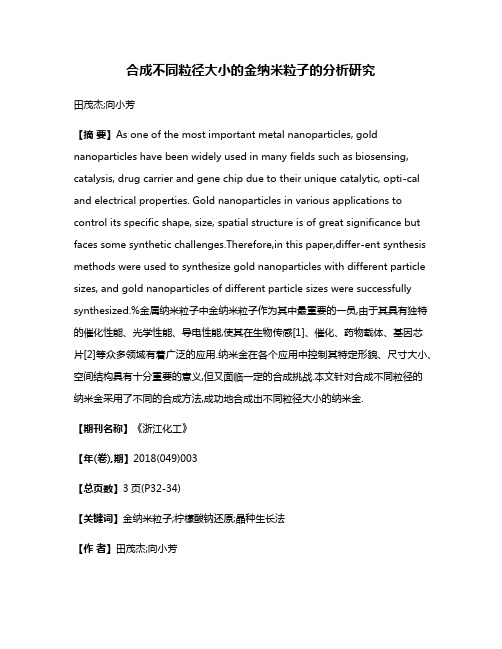
合成不同粒径大小的金纳米粒子的分析研究田茂杰;向小芳【摘要】As one of the most important metal nanoparticles, gold nanoparticles have been widely used in many fields such as biosensing, catalysis, drug carrier and gene chip due to their unique catalytic, opti-cal and electrical properties. Gold nanoparticles in various applications to control its specific shape, size, spatial structure is of great significance but faces some synthetic challenges.Therefore,in this paper,differ-ent synthesis methods were used to synthesize gold nanoparticles with different particle sizes, and gold nanoparticles of different particle sizes were successfully synthesized.%金属纳米粒子中金纳米粒子作为其中最重要的一员,由于其具有独特的催化性能、光学性能、导电性能,使其在生物传感[1]、催化、药物载体、基因芯片[2]等众多领域有着广泛的应用.纳米金在各个应用中控制其特定形貌、尺寸大小、空间结构具有十分重要的意义,但又面临一定的合成挑战.本文针对合成不同粒径的纳米金采用了不同的合成方法,成功地合成出不同粒径大小的纳米金.【期刊名称】《浙江化工》【年(卷),期】2018(049)003【总页数】3页(P32-34)【关键词】金纳米粒子;柠檬酸钠还原;晶种生长法【作者】田茂杰;向小芳【作者单位】成都理工大学材料与化学化工学院,四川成都610059;成都理工大学材料与化学化工学院,四川成都610059【正文语种】中文1 实验部分1.1 仪器及试剂电子分析天平、pH计、恒温磁力搅拌器、紫外-可见光谱仪、扫描电子显微镜等仪器;聚二烯丙基二甲基氯化铵(PDDA)、氧化铟锡导电玻璃(ITO)、氯金酸,柠檬酸钠、草酸钠、硼氰化钠、氢氧化钠、磷酸二氢钠、磷酸氢二钠、浓硝酸、浓盐酸等试剂。
纳米金尺寸对应紫外峰

Supporting Information‘Determination of Size and Concentration of Gold Nanoparticles from UV/vis Spectra’Wolfgang Haiss*1,2, Nguyen T. K. Thanh1,2, Jenny Aveyard1 and David G. Fernig2Centre for Nanoscale Science,1Department of Chemistry, University of Liverpool, Crown Street L69 7ZD, U.K2School of Biological Sciences, University of Liverpool, Crown Street L69 7ZB, U.KTable of Content1. Tabular material for the determination of the size of uncoated spherical gold nanoparticles in water from UV/vis spectra.2. Tabular Material for the determination of the concentration of uncoated spherical gold nanoparticles in water from UV/vis spectra.3. The FORTRAN 77 program ‘mie-mfp.f’ which was used to calculate Q ext(λ,d).1. Tabular material for the determination of the size of uncoated spherical gold nanoparticles in water from UV/vis spectra.The values in Tables S-1 and S-2 can be used to calculate the size of GNPs form UV/vis spectra. For particles having a diameter larger than 35 nm Table S-1 and Table S-2 can be used to determine the particle diameter d. For smaller particles the absorbance ratio of Table S-2 can be used but it should be noted that particle sizes can be obtained from Equation 12 with slightly improved precision if the initial gold concentration is known. For particle diameters smaller than 10 nm the values in Table S-2 should only be considered as an estimate since surface effects may get increasingly important in this size region.λspr/ nm d / nm λspr / nm d / nm λspr / nm d / nm 525.0 32 534.9 58 552.1 84 525.6 34 535.9 60 553.8 86 526.2 36 536.9 62 555.7 88 526.8 38 538.0 64 557.6 90 527.5 40 539.2 66 559.6 92 528.2 42 540.4 68 561.7 94 528.9 44 541.6 70 563.9 96 529.6 46 542.9 72 566.2 98 530.4 48 544.3 74 568.6 100 531.2 50 545.7 76 571.1 102 532.1 52 547.2 78 573.7 104 533.0 54 548.8 80 576.5 106 533.9 56 550.4 82 579.3 108Table S-1: Position of the surface plasmon resonance peak in dependence of the particle diameter calculated from Equation 10.A spr/A450 d / nm A spr/A450 d / nm A spr/A450 d / nm1.10 3 1.56 12 1.96 401.19 4 1.61 142.00 451.27 5 1.65 162.03 501.33 6 1.69 182.07 551.387 1.73 202.10 601.428 1.80 252.12 651.469 1.86 302.15 701.5010 1.92 352.17 75Table S-2: Ratio of the absorbance of GNPs at the surface plasma resonance peak (A spr) to the absorbance at 450 nm (A450) in dependence the particle diameter calculated from Equation 11 using the fit parameters to the experimental results.2. Tabular material for the determination the concentration of uncoated spherical gold nanoparticles in water from UV/vis spectra.The data of ε450(d ) in Table S-3 can be used to calculate the particle concentration c in mol per litre from the absorption A at 450 nm for a standard path length l of 1 cm according to:c = A 450/ε450The data have been experimentally verified in the d range from 5 – 100 nm (see Figure 8). For particle diameters smaller than 5 nm the values should only be considered as an estimate since surface effects may get increasingly important in this size region.d /nm ε450 / M -1cm -1 d / nm ε450 / M -1cm -1d / nm ε450 / M -1cm -12 4.25E+0535 3.21E+09 68 2.50E+103 1.49E+06 36 3.52E+09 69 2.61E+104 3.62E+06 37 3.84E+09 70 2.71E+105 7.20E+06 38 4.18E+09 71 2.82E+10 6 1.26E+07 39 4.54E+09 72 2.93E+10 7 2.03E+07 40 4.92E+09 73 3.05E+108 3.07E+07 41 5.32E+09 74 3.16E+10 9 4.43E+07 42 5.74E+09 75 3.28E+10 10 6.15E+07 43 6.18E+09 76 3.40E+10 11 8.27E+07 44 6.65E+09 77 3.52E+10 12 1.09E+08 45 7.13E+09 78 3.64E+10 13 1.39E+08 46 7.65E+09 79 3.77E+10 14 1.76E+08 47 8.18E+09 80 3.89E+10 15 2.18E+08 48 8.74E+09 81 4.02E+10 16 2.67E+08 49 9.32E+09 82 4.14E+10 17 3.24E+08 50 9.92E+09 83 4.27E+10 18 3.87E+08 51 1.06E+10 84 4.40E+10 19 4.60E+08 52 1.12E+10 85 4.53E+10 20 5.41E+08 53 1.19E+10 86 4.65E+10 21 6.31E+08 54 1.26E+10 87 4.78E+10 22 7.31E+08 55 1.33E+10 88 4.91E+10 23 8.42E+08 56 1.41E+10 89 5.04E+10 24 9.64E+08 57 1.48E+10 90 5.17E+10 25 1.10E+09 58 1.57E+10 91 5.30E+10 26 1.24E+09 59 1.65E+10 92 5.43E+10 27 1.40E+09 60 1.73E+10 93 5.56E+10 28 1.58E+09 61 1.82E+10 94 5.69E+10 29 1.76E+09 62 1.91E+10 95 5.82E+10 30 1.96E+09 63 2.00E+10 96 5.94E+10 31 2.18E+09 64 2.10E+10 97 6.07E+10 32 2.41E+09 65 2.19E+10 98 6.19E+10 33 2.66E+09 66 2.29E+10 99 6.31E+10 34 2.93E+0967 2.40E+10100 6.44E+10Table S-3: Molar decadic extinction coefficient (ε) at λ = 450 nm calculated from the fit (Equation 13) to the theoretical extinction efficiencies for gold nano particles in water with diameter d ranging from 2 to 100 nm.3. The FORTRAN 77 program ‘mie-mfp.f’ which was used to calculate Q ext(λ,d). PROGRAM MIE-MFPREAL A(1100), B(1100), C(1100)COMPLEX RFREL1,RFREL2CHARACTER*64 file_in, file_outC ***************************************************************C This program calculates the scattering efficiency (QSCA;col2),C the extinction efficiency (QEXT;col3) for a coated sphereC using Mie theory. The wavelength of the incident lightC is scanned between two values with a step-width.C The complex refractive index of the sphere as a functionC of the wavelength/nm in vacuum is read in from a separate file.C Linear interpolation is used to interpolate theseC experimentally determined data.C ***************************************************************C ***************************************************************C Input of parameters:WRITE(6,*) 'ENTER THE START WAVELENGT / NM:'READ(5,*) WAVEL1WRITE(6,*) 'ENTER END WAVELENGT / NM:'READ(5,*) WAVEL2WRITE(6,*) 'ENTER THE NUMBER OF VALUES TO BE CALCULATED:'READ(5,*) NUMVALWRITE(6,*) 'REFRACTIVE INDEX OF THE SURROUNDING MEDIUM:'READ(5,*) REFMEDWRITE(6,*) 'REAL PART REFRACTIVE INDEX OF THE COATING:'READ(5,*) REFRE2WRITE(6,*) 'IMMAG. PART OF THE REFR. INDEX OF THE COATING:'READ(5,*) REFIM2WRITE(6,*) 'SPHERE RADIUS / NM:'READ(5,*) RADCORWRITE(6,*) 'COATING RADIUS / NM:'READ(5,*) RADCOTWRITE(6,*) 'ENTER THE PLASMA FREQUENCY IN HZ/1E+14 (138. for Au):'READ(5,*) OMPWRITE(6,*) 'ENTER THE COLLISION FREQ. IN Hz/1E+14 (0.333 for Au):'READ(5,*) OM0WRITE(6,*) 'ENTER END FERMI VELOCITY IN cm/s (1.4E+8 for Au):'READ(5,*) FVWRITE(6,*) 'SPECIFY THE FILENAME OF THE CORE REFRACTIVE INDEX:'READ(5,'(A)') file_inWRITE(6,*) 'SPECIFY THE FILENAME OF THE OUTPUT FILE:'READ(5,'(A)') file_outC ***************************************************************pi=3.14159265TAU= (1/OM0)*1E-14FMPINF=FV*TAUC ***************************************************************C Output of parameters to file_out:OPEN(UNIT=11,FILE=file_out,STATUS='NEW')WRITE(11,*) 'WAV ','QSCA ','QEXT ','NSTOP 'C ***************************************************************C ***************************************************************C Data of REFRE1 (col2;B(K)) and REFIM1 (col3;C(K))are read fromC the input file into 1-dimensional arrays (A=WAVEL; B=n; C=k).C Note that the data-file must contain increasing values of theC wavelength in column 1 it also must contain a single number inC line 1, specifying the total Nr of Data lines.OPEN(UNIT=10,FILE=file_in,STATUS='OLD')READ(10,*) NDO 5 K=1,NREAD(10,*) A(K), B(K), C(K)5 CONTINUEC ***************************************************************C Calculating the wavelength step-width:DELTA = (WAVEL2 - WAVEL1)/(NUMVAL - 1)C Repeating the calculations:DO 100 I = 1,NUMVALWAVEL = WAVEL1 + (I-1)*DELTAC ***************************************************************C Linear interpolation of n and k from input file:IF(WAVEL.EQ.A(1)) THENK=1ELSEK=215 IF (A(K).LT.WAVEL) THENK=K+1GO TO 15END IFrn = B(K-1) + (WAVEL - A(K-1))/(A(K) - A(K-1))*(B(K) - B(K-1))rk = C(K-1) + (WAVEL - A(K-1))/(A(K) - A(K-1))*(C(K) - C(K-1))END IFC ***************************************************************CALL MFP (FV,WAVEL,RADCOR,OMP,OM0,rn,rk,rnr,rkr,OM0R)C This Subroutine corrects the bulk values of n and k for smallC particles taking into account the 'mean free path effect' onC the 'free' conduction electrons in the Drude model.REFRE1 = rnrREFIM1 = rkrTAUR=(1/OM0R)*1E-14FMPR=FV*TAURC Calculating relative size parameters for core (X) and coating (Y) X=2.*pi*RADCOR*REFMED/WAVELy=2.*pi*RADCOT*REFMED/WAVELC Calculating the complex relative refractive indices:RFREL1=CMPLX(REFRE1,REFIM1)/REFMEDRFREL2=CMPLX(REFRE2,REFIM2)/REFMEDCALL BHCOAT (X,Y,RFREL1,RFREL2,QEXT,QSCA,QBACK,NSTOP)C Recalibration of the scattering efficiencies QC with respect to RADCOR instead of RADCOTQEXT = QEXT*(RADCOT/RADCOR)*(RADCOT/RADCOR)QSCA = QSCA*(RADCOT/RADCOR)*(RADCOT/RADCOR)QBACK= QBACK*(RADCOT/RADCOR)*(RADCOT/RADCOR)WRITE (11,*) WAVEL,QSCA,QEXT,NSTOP100 CONTINUEWRITE(11,*) 'FMPINF: ',FMPINF ,'cm 'WRITE(11,*) 'FMPR: ',FMPR ,'cm 'WRITE(11,*) 'TAU: ',TAU ,'s 'WRITE(11,*) 'TAUR: ',TAUR ,'s 'WRITE(11,*) 'OMP: ',OMP ,'1E+14Hz 'WRITE(11,*) 'OM0: ',OM0 ,'1E+14Hz 'WRITE(11,*) 'FER-VEL: ',FV,'cm/s 'WRITE(11,*) 'REFMED: ',REFMEDWRITE(11,*) 'REFRE2: ',REFRE2WRITE(11,*) 'REFIM2: ',REFIM2WRITE(11,*) 'RADCOR: ',RADCORWRITE(11,*) 'RADCOT: ',RADCOTWRITE(11,*) 'FILEIN: ',file_inWRITE(11,*) 'FILEOUT: ',file_outSTOPENDSUBROUTINE BHCOAT (X,Y,RFREL1,RFREL2,QEXT,QSCA,QBACK,NSTOP)C *************************************************************** C The Subroutine BHCOAT was produced from the original FORTRANC code of Bohren and Huffman which can be found in the appendix C of their Book: Bohren, C. F.; Huffman, D. R.C Absorption and Scattering of Light by Small Particles;C Wiley Interscience: New York, 1983C *************************************************************** COMPLEX RFREL1,RFREL2,X1,X2,Y2,REFRELCOMPLEX D1X1,D0X1,D1X2,D0X2,D1Y2,D0Y2COMPLEX XI0Y,XI1Y,XIY,CHI0Y2,CHI1Y2,CHIY2,CHI0X2,CHI1X2,CHIX2COMPLEX CHIPX2,CHIPY2,ANCAP,BNCAP,DNBAR,GNBAR,AN,BN,CRACK,BRACK COMPLEX XBACK,AMESS1,AMESS2,AMESS3,AMESS4DEL=1.0E-8X1=RFREL1*XX2=RFREL2*XY2=RFREL2*YYSTOP = Y + 4.*Y**.3333 + 2.REFREL=RFREL2/RFREL1NSTOP = YSTOPD0X1=CCOS(X1)/CSIN(X1)D0X2=CCOS(X2)/CSIN(X2)D0Y2=CCOS(Y2)/CSIN(Y2)PSI0Y=COS(Y)PSI1Y=SIN(Y)CHI0Y=-SIN(Y)CHI1Y=COS(Y)XI0Y=CMPLX(PSI0Y,-CHI0Y)XI1Y=CMPLX(PSI1Y,-CHI1Y)CHI0Y2=-CSIN(Y2)CHI1Y2=CCOS(Y2)CHI0X2=-CSIN(X2)CHI1X2=CCOS(X2)QSCA=0.0QEXT=0.0XBACK=CMPLX(0.0,0.0)N=1IFLAG=0200 RN=NPSIY=(2.*RN-1.)*PSI1Y/Y-PSI0YCHIY=(2.*RN-1.)*CHI1Y/Y-CHI0YXIY=CMPLX(PSIY,-CHIY)D1Y2=1./(RN/Y2-D0Y2)-RN/Y2IF (IFLAG.EQ.1) GO TO 999D1X1=1./(RN/X1-D0X1)-RN/X1D1X2=1./(RN/X2-D0X2)-RN/X2CHIX2=(2.*RN-1.)*CHI1X2/X2-CHI0X2CHIY2=(2.*RN-1.)*CHI1Y2/Y2-CHI0Y2CHIPX2=CHI1X2-RN*CHIX2/X2CHIPY2=CHI1Y2-RN*CHIY2/Y2ANCAP=REFREL*D1X1-D1X2ANCAP=ANCAP/(REFREL*D1X1*CHIX2-CHIPX2)ANCAP=ANCAP/(CHIX2*D1X2-CHIPX2)BRACK=ANCAP*(CHIY2*D1Y2-CHIPY2)BNCAP=REFREL*D1X2-D1X1BNCAP=BNCAP/(REFREL*CHIPX2-D1X1*CHIX2)BNCAP=BNCAP/(CHIX2*D1X2-CHIPX2)CRACK=BNCAP*(CHIY2*D1Y2-CHIPY2)AMESS1=BRACK*CHIPY2AMESS2=BRACK*CHIY2AMESS3=CRACK*CHIPY2AMESS4=CRACK*CHIY2IF(CABS(AMESS1).GT.DEL*CABS(D1Y2)) GO TO 999IF(CABS(AMESS2).GT.DEL) GO TO 999IF(CABS(AMESS3).GT.DEL*CABS(D1Y2)) GO TO 999IF(CABS(AMESS4).GT.DEL) GO TO 999BRACK=CMPLX(0.0,0.0)CRACK=CMPLX(0.0,0.0)IFLAG=1999 DNBAR=D1Y2-BRACK*CHIPY2DNBAR=DNBAR/(1.-BRACK*CHIY2)GNBAR=D1Y2-CRACK*CHIPY2GNBAR=GNBAR/(1.-CRACK*CHIY2)AN=(DNBAR/RFREL2+RN/Y)*PSIY-PSI1YAN=AN/((DNBAR/RFREL2+RN/Y)*XIY-XI1Y)BN=(RFREL2*GNBAR+RN/Y)*PSIY-PSI1YBN=BN/((RFREL2*GNBAR+RN/Y)*XIY-XI1Y)QSCA=QSCA+(2.*RN+1.)*(CABS(AN)*CABS(AN)+CABS(BN)*CABS(BN))XBACK=XBACK+(2.*RN+1.)*(-1.)**N*(AN-BN)QEXT=QEXT+(2.*RN+1.)*(REAL(AN)+REAL(BN))PSI0Y=PSI1YPSI1Y=PSIYCHI0Y=CHI1YCHI1Y=CHIYXI1Y=CMPLX(PSI1Y,-CHI1Y)CHI0X2=CHI1X2CHI1X2=CHIX2CHI0Y2=CHI1Y2CHI1Y2=CHIY2D0X1=D1X1D0X2=D1X2D0Y2=D1Y2N=N+1IF(N-1-NSTOP) 200,300,300300 QSCA=(2./(Y*Y))*QSCAQEXT=(2./(Y*Y))*QEXTQBACK=XBACK*CONJG(XBACK)QBACK=(1./(Y*Y))*QBACKRETURNENDSUBROUTINE MFP (FV,WAVEL,RADCOR,OMP,OM0,rn,rk,rnr,rkr,OM0R)C *************************************************************** C This program corrects the bulk values of n and k for smallC particles taking into account the 'mean free path effect' onC the 'free' conduction electrons in the extended Drude model.C All calculations performed in cm-g-s units.C Plasma Frequency and collision frequency both internally devided C by 1E+14 to avoid overflowC *************************************************************** CL = 2.998E+10pi = 3.14159265C Calculate EPS1 and EPS2 from rn and rk:EPS1 = rn*rn - rk*rkEPS2 = 2.*rn*rkC Calculate OM and A1 and A2:OM = (2.*pi*CL/(WAVEL*1.E-7))/1.E+14A1 = 1.-(OMP*OMP/(OM*OM + OM0*OM0))A2 = OMP*OMP*OM0/(OM*(OM*OM + OM0*OM0))C Contribution of the bond electrons to n (B1) and k (B2):B1 = EPS1 - A1B2 = EPS2 - A2C Calculate R dependent OM0 (OM0R)OM0R = OM0 + (FV/(RADCOR*1.E-7))/1.E+14C Calculate R dependent contributions of the free electrons:A1R = 1.-(OMP*OMP/(OM*OM + OM0R*OM0R))A2R = OMP*OMP*OM0R/(OM*(OM*OM + OM0R*OM0R))C Calculate R dependent EPS (EPS1R and EPS2R)EPS1R = A1R + B1EPS2R = A2R + B2C Reconvert EPS1R and EPS2R back to n and k:rnr = SQRT((A1R + B1)/2. + SQRT((A1R/2.+B1/2.)*(A1R/2.+B1/2.)_+(A2R/2.+B2/2.)*(A2R/2.+B2/2.)))rkr = SQRT(-(A1R + B1)/2. + SQRT((A1R/2.+B1/2.)*(A1R/2.+B1/2.)_+(A2R/2.+B2/2.)*(A2R/2.+B2/2.)))C WRITE(6,*) 'rn= ',rnC WRITE(6,*) 'rnr= ',rnrC WRITE(6,*) 'OM0= ',OM0C WRITE(6,*) 'OM0R= ',OM0RC WRITE(6,*) 'OM= ',OMEND。
纳米颗粒的功能作文

纳米颗粒的功能作文英文回答:Nanoparticles are tiny particles that have unique properties due to their small size. These particles are typically less than 100 nanometers in size, making them much smaller than a human hair. Despite their small size, nanoparticles have a wide range of functionalities and applications in various fields.One of the main functions of nanoparticles is their ability to enhance the properties of materials. For example, nanoparticles can be added to coatings to make them more resistant to scratches or stains. They can also be used to improve the strength and durability of materials such as metals and ceramics. By incorporating nanoparticles into these materials, their mechanical, thermal, and electrical properties can be significantly enhanced.Another important function of nanoparticles is theirability to deliver drugs and therapeutic agents to specific targets in the body. Nanoparticles can be designed to carry drugs and release them in a controlled manner, allowing for targeted drug delivery. This can improve the efficacy of treatments and minimize side effects. For example, nanoparticles can be used to deliver chemotherapy drugs directly to cancer cells, reducing damage to healthy tissues.Furthermore, nanoparticles have unique optical properties that can be utilized in various applications. For instance, gold nanoparticles can absorb and scatter light in a specific way, making them useful in biomedical imaging techniques such as photoacoustic imaging and surface-enhanced Raman spectroscopy. These techniques can provide detailed information about biological tissues and help diagnose diseases.中文回答:纳米颗粒是一种非常小的颗粒,由于其微小的尺寸,具有独特的性质。
The role of nanocatalysts in green chemistry
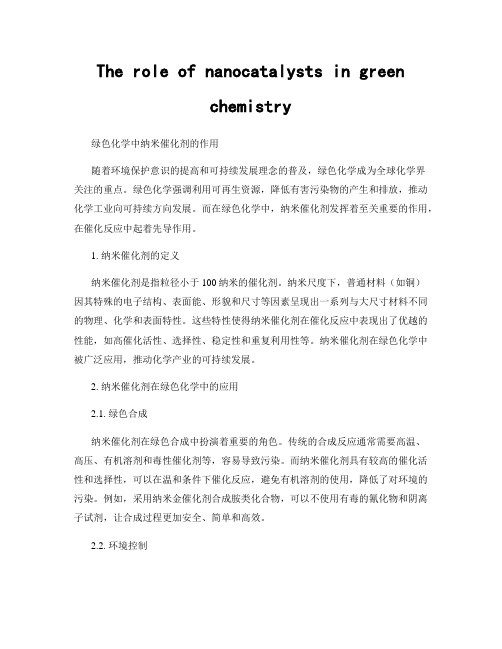
The role of nanocatalysts in greenchemistry绿色化学中纳米催化剂的作用随着环境保护意识的提高和可持续发展理念的普及,绿色化学成为全球化学界关注的重点。
绿色化学强调利用可再生资源,降低有害污染物的产生和排放,推动化学工业向可持续方向发展。
而在绿色化学中,纳米催化剂发挥着至关重要的作用,在催化反应中起着先导作用。
1. 纳米催化剂的定义纳米催化剂是指粒径小于100纳米的催化剂。
纳米尺度下,普通材料(如铜)因其特殊的电子结构、表面能、形貌和尺寸等因素呈现出一系列与大尺寸材料不同的物理、化学和表面特性。
这些特性使得纳米催化剂在催化反应中表现出了优越的性能,如高催化活性、选择性、稳定性和重复利用性等。
纳米催化剂在绿色化学中被广泛应用,推动化学产业的可持续发展。
2. 纳米催化剂在绿色化学中的应用2.1. 绿色合成纳米催化剂在绿色合成中扮演着重要的角色。
传统的合成反应通常需要高温、高压、有机溶剂和毒性催化剂等,容易导致污染。
而纳米催化剂具有较高的催化活性和选择性,可以在温和条件下催化反应,避免有机溶剂的使用,降低了对环境的污染。
例如,采用纳米金催化剂合成胺类化合物,可以不使用有毒的氰化物和阴离子试剂,让合成过程更加安全、简单和高效。
2.2. 环境控制纳米催化剂在环境控制领域的应用越来越受到关注。
例如,在水处理中,纳米催化剂可以分解有害污染源,如工业废水中的重金属离子和有机污染物,大大减少了污染物对环境的危害。
2.3. 能源转化纳米催化剂在能源转化方面也有着广泛的应用。
例如,在绿色氢能产业中,纳米催化剂可以在低温下催化水的分解反应,产生的氢气可以用于燃料电池发电。
3. 纳米催化剂的制备纳米催化剂的制备方法多种多样。
其中,溶胶-凝胶法、微乳液法、共沉淀法和物理气相沉积法等方法得到了广泛应用。
不同制备方法对于纳米催化剂的制备效果有所差异。
溶胶-凝胶法可以制备出粒度小、结构高度有序的纳米催化剂;微乳液法则可以得到高度分散的纳米团簇;共沉淀法适用于制备堆积型纳米催化剂;而物理气相沉积法则可以制备出具有高度均匀性、形貌可控且尺寸精密的纳米催化剂。
纳米金属颗粒物原位催化 英文
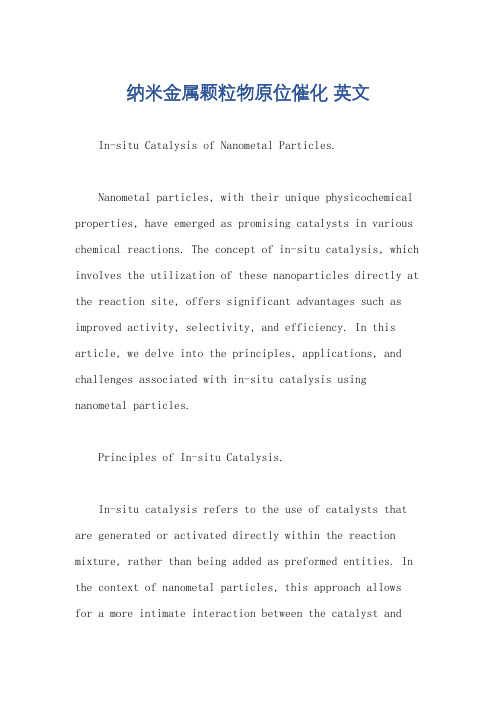
纳米金属颗粒物原位催化英文In-situ Catalysis of Nanometal Particles.Nanometal particles, with their unique physicochemical properties, have emerged as promising catalysts in various chemical reactions. The concept of in-situ catalysis, which involves the utilization of these nanoparticles directly at the reaction site, offers significant advantages such as improved activity, selectivity, and efficiency. In this article, we delve into the principles, applications, and challenges associated with in-situ catalysis using nanometal particles.Principles of In-situ Catalysis.In-situ catalysis refers to the use of catalysts that are generated or activated directly within the reaction mixture, rather than being added as preformed entities. In the context of nanometal particles, this approach allowsfor a more intimate interaction between the catalyst andthe reactants, leading to enhanced catalytic activity. The small size of these nanoparticles ensures a high surface-to-volume ratio, which in turn results in a greater numberof active sites available for catalysis.The catalytic activity of nanometal particles isfurther enhanced by their unique electronic and structural properties. The quantum size effects observed in nanoparticles lead to changes in their electronic structure, which can significantly alter their catalytic behavior. Additionally, the high surface energy of nanoparticles promotes their stability and prevents sintering, even at elevated temperatures, maintaining their catalytic activity over extended periods.Applications of In-situ Catalysis.The applications of in-situ catalysis using nanometal particles are diverse and span across various fields of chemistry and engineering. Some of the key applications include:1. Organic Synthesis: Nanometal particles, especially those of platinum, palladium, and gold, have found widespread use in organic synthesis reactions such as hydrogenation, carbon-carbon bond formation, and oxidation reactions. Their use in in-situ catalysis allows for more efficient and selective transformations.2. Fuel Cells: Nanometal particles, particularly those of platinum and palladium, are key components in the electrodes of fuel cells. Their in-situ catalysis promotes the efficient oxidation of fuels such as hydrogen, leading to improved fuel cell performance.3. Photocatalysis: The combination of nanometal particles with photocatalysts such as titanium dioxide offers a powerful tool for solar-driven reactions. The in-situ generation of reactive species at the interface of these materials enhances photocatalytic activity and selectivity.Challenges and Future Directions.While the potential of in-situ catalysis using nanometal particles is immense, there are several challenges that need to be addressed. One of the key challenges is the stability of these nanoparticles under reaction conditions. The aggregation and sintering of nanoparticles can lead to a decrease in their catalytic activity. To address this, strategies such as stabilization by ligands or supports, and the use of bimetallic or core-shell structures have been explored.Another challenge lies in the scale-up of these processes for industrial applications. While laboratory-scale experiments often demonstrate promising results, translating these findings to large-scale operations can be challenging due to factors such as mass transport limitations and heat management.Future research in in-situ catalysis with nanometal particles could focus on developing more robust and stable catalyst systems. The exploration of new nanomaterials with enhanced catalytic properties, as well as the optimization of reaction conditions and reactor designs, are likely tobe key areas of interest. Additionally, the integration ofin-situ catalysis with other technologies such as microfluidics and nanoreactors could lead to more efficient and sustainable catalytic processes.In conclusion, the field of in-situ catalysis using nanometal particles offers significant potential for enhancing the efficiency and selectivity of chemical reactions. While there are still challenges to be addressed, the ongoing research in this area is likely to lead to transformative advancements in catalysis and beyond.。
纳米技术分离锂电池正负极材料

纳米技术分离锂电池正负极材料英文回答:Nanotechnology has revolutionized various industries, and one area where it has shown great potential is in the separation of lithium-ion battery electrode materials. Lithium-ion batteries are widely used in portableelectronic devices and electric vehicles, and theefficiency and performance of these batteries depend on the quality and purity of the electrode materials.One of the challenges in lithium-ion battery production is the separation of the positive and negative electrode materials. Traditional methods such as sieving and centrifugation are not efficient enough to achieve the desired level of separation. However, nanotechnology offers promising solutions to this problem.One approach is the use of nanoscale membranes orfilters that can selectively separate the positive andnegative electrode materials based on their size or charge. For example, researchers have developed nanoporous membranes that can allow the passage of lithium ions while blocking larger particles. This allows for the separation of the positive and negative electrode materials without the need for extensive purification steps.Another approach is the use of nanoscale coatings on the electrode materials. These coatings can selectively bind to either the positive or negative electrode material, allowing for their easy separation. For instance, a nanoscale coating that specifically binds to the positive electrode material can be used to selectively remove it from a mixture of electrode materials.Furthermore, nanotechnology can also be used to enhance the performance of the electrode materials themselves. For example, the use of nanoscale additives or modifiers can improve the conductivity and stability of the electrode materials, leading to better overall battery performance.In summary, nanotechnology offers innovative solutionsfor the separation of lithium-ion battery electrode materials. Nanoscale membranes, coatings, and additives can be used to selectively separate the positive and negative electrode materials, improving the efficiency and performance of lithium-ion batteries.中文回答:纳米技术在各个行业都起到了革命性的作用,其中一个领域是锂电池正负极材料的分离。
The role of nanoparticles in catalysis
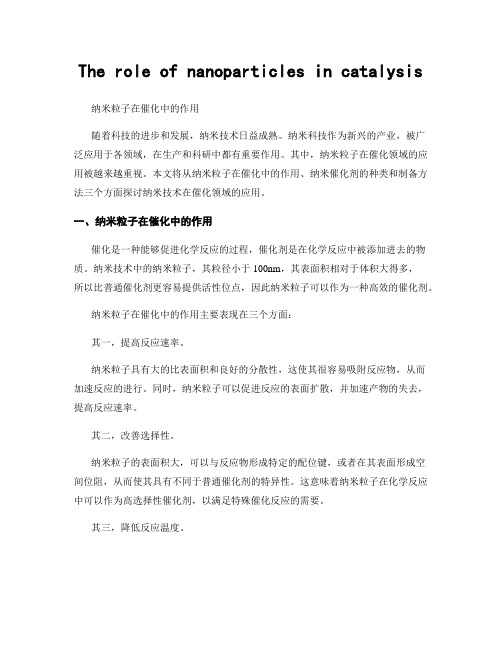
The role of nanoparticles in catalysis 纳米粒子在催化中的作用随着科技的进步和发展,纳米技术日益成熟。
纳米科技作为新兴的产业,被广泛应用于各领域,在生产和科研中都有重要作用。
其中,纳米粒子在催化领域的应用被越来越重视。
本文将从纳米粒子在催化中的作用、纳米催化剂的种类和制备方法三个方面探讨纳米技术在催化领域的应用。
一、纳米粒子在催化中的作用催化是一种能够促进化学反应的过程,催化剂是在化学反应中被添加进去的物质。
纳米技术中的纳米粒子,其粒径小于100nm,其表面积相对于体积大得多,所以比普通催化剂更容易提供活性位点,因此纳米粒子可以作为一种高效的催化剂。
纳米粒子在催化中的作用主要表现在三个方面:其一,提高反应速率。
纳米粒子具有大的比表面积和良好的分散性,这使其很容易吸附反应物,从而加速反应的进行。
同时,纳米粒子可以促进反应的表面扩散,并加速产物的失去,提高反应速率。
其二,改善选择性。
纳米粒子的表面积大,可以与反应物形成特定的配位键,或者在其表面形成空间位阻,从而使其具有不同于普通催化剂的特异性。
这意味着纳米粒子在化学反应中可以作为高选择性催化剂,以满足特殊催化反应的需要。
其三,降低反应温度。
传统的催化剂本身也可以降低反应温度,但通常的效果比较有限。
而纳米粒子在催化过程中不仅可以提高反应率和选择性,而且还可以降低催化反应的温度,使其适用于低温催化和绿色化工领域。
二、纳米催化剂的种类为了更好地了解纳米粒子在催化中的作用,我们需要进一步了解一下纳米催化剂的种类。
目前,纳米催化剂主要分为金属催化剂、金属氧化物催化剂、碳基催化剂和离子液体催化剂。
金属催化剂是最常见的催化剂之一,其主要成分是金属,如铂、钯、铜、铁和铑等。
纳米粒子化的金属催化剂比普通催化剂更容易提供活性位点,有着更高的反应速度和选择性。
金属氧化物催化剂是另一种常见的催化剂类型,如二氧化钛、氧化锌、氧化铝等。
这些纳米催化剂可以通过控制其晶体结构和粒径来改变其表面酸性和碱性,从而进一步调节其催化性质和活性位点。
有关纳米的英语作文题目
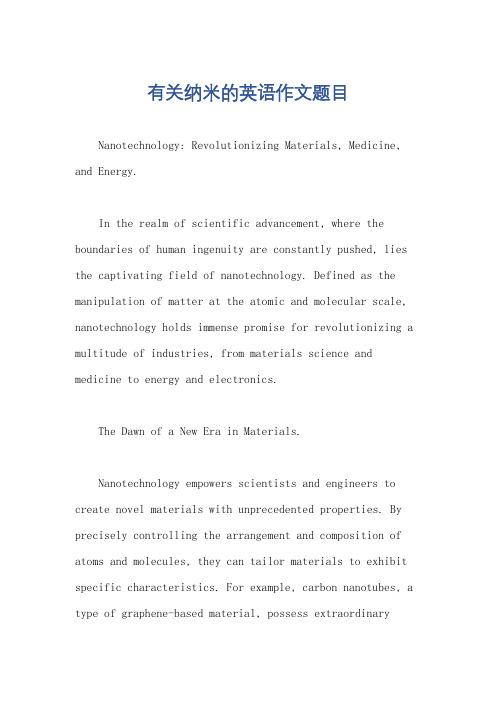
有关纳米的英语作文题目Nanotechnology: Revolutionizing Materials, Medicine, and Energy.In the realm of scientific advancement, where the boundaries of human ingenuity are constantly pushed, lies the captivating field of nanotechnology. Defined as the manipulation of matter at the atomic and molecular scale, nanotechnology holds immense promise for revolutionizing a multitude of industries, from materials science and medicine to energy and electronics.The Dawn of a New Era in Materials.Nanotechnology empowers scientists and engineers to create novel materials with unprecedented properties. By precisely controlling the arrangement and composition of atoms and molecules, they can tailor materials to exhibit specific characteristics. For example, carbon nanotubes, a type of graphene-based material, possess extraordinarystrength and electrical conductivity, making them suitable for applications in lightweight composites, flexible electronics, and energy storage devices. Similarly, nanocrystalline materials, with their enhanced toughness and corrosion resistance, have potential in aerospace components, medical implants, and automotive parts.Transforming Healthcare with Precision and Control.In the realm of medicine, nanotechnology has opened up exciting avenues for disease diagnosis, targeted drug delivery, and regenerative therapies. Nanoparticles can be engineered to encapsulate and deliver drugs directly to diseased cells, increasing efficacy while minimizing side effects. They can also serve as diagnostic tools, allowing for early detection of diseases through sensitive biosensing mechanisms. Moreover, nanomaterials are being explored for tissue engineering and regenerative medicine, with the potential to repair damaged tissue and restore lost functionality.Harnessing Nanotech Innovations for Energy Solutions.The global energy crisis and concerns about environmental sustainability have fueled the search for renewable and efficient energy sources. Nanotechnology plays a crucial role in this quest by enabling the development of advanced solar cells, batteries, and fuel cells. Nanostructured materials, with their enhanced light absorption and charge transport properties, can improve the efficiency of solar panels. Nanoengineered batteries, featuring high energy density and fast charging capabilities, hold promise for powering electric vehicles and portable electronics. Furthermore, nanocatalysts can accelerate chemical reactions, making fuel cells more efficient and reducing reliance on fossil fuels.Pioneering Applications in Electronics and Technology.The miniaturization and integration of electronic devices has driven the development of nanotechnology as a key enabler. Nanoscale transistors, with their reduced size and power consumption, allow for the creation of more powerful and energy-efficient electronics. Nanomaterialsalso contribute to the advancement of sensing technologies, enabling the development of compact and highly sensitive sensors for various applications, ranging from medical diagnostics to environmental monitoring.Ethical Considerations and the Responsible Use of Nanotechnology.As with any transformative technology, nanotechnology raises important ethical considerations. Concerns have been raised about the potential risks associated with the release of engineered nanoparticles into the environment and their impact on human health. It is essential to establish guidelines and regulations to ensure the responsible and safe utilization of nanomaterials.Conclusion.Nanotechnology represents a transformative force in modern science and technology, offering the potential to revolutionize industries, improve human health, and address global challenges. By manipulating matter at the atomic andmolecular scale, scientists and engineers are unlocking a world of possibilities. However, as we harness the power of nanotechnology, it is imperative to proceed with caution and implement appropriate safeguards to ensure the ethical and sustainable use of this transformative technology.。
有关纳米的英语作文题目400字
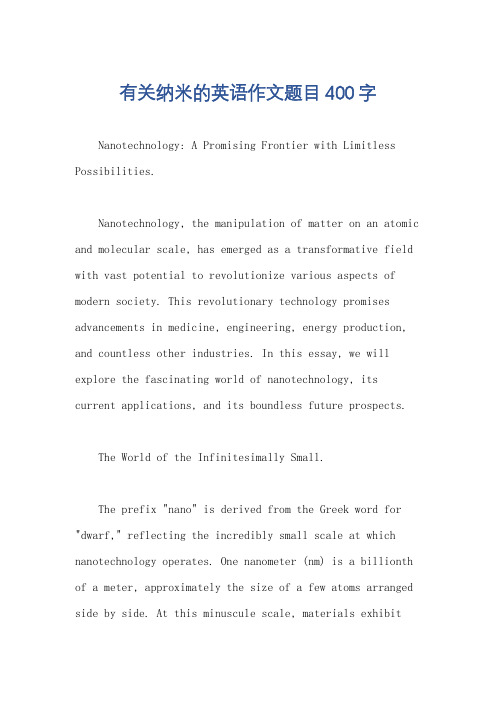
有关纳米的英语作文题目400字Nanotechnology: A Promising Frontier with Limitless Possibilities.Nanotechnology, the manipulation of matter on an atomic and molecular scale, has emerged as a transformative field with vast potential to revolutionize various aspects of modern society. This revolutionary technology promises advancements in medicine, engineering, energy production, and countless other industries. In this essay, we will explore the fascinating world of nanotechnology, its current applications, and its boundless future prospects.The World of the Infinitesimally Small.The prefix "nano" is derived from the Greek word for "dwarf," reflecting the incredibly small scale at which nanotechnology operates. One nanometer (nm) is a billionth of a meter, approximately the size of a few atoms arranged side by side. At this minuscule scale, materials exhibitunique properties that differ significantly from their bulk counterparts. This extraordinary phenomenon forms the foundation for the remarkable applications of nanotechnology.Medical Marvels.Nanotechnology holds immense promise forrevolutionizing healthcare. Nanoparticles, designed with specific properties and functionalities, can be engineered to deliver drugs and therapies directly to diseased cells, minimizing side effects and improving treatment efficacy. Additionally, nanotechnology enables the development of highly sensitive biosensors capable of detecting trace amounts of biomarkers, allowing for early diagnosis and precise patient monitoring.Engineering Innovations.In the field of engineering, nanotechnology has ushered in a new era of lightweight, durable, and multifunctional materials. Carbon nanotubes, for instance, areexceptionally strong and possess excellent electrical conductivity, making them ideal for use in aerospace, automotive, and electronics applications. Nanomaterials also find applications in water purification, energy storage, and the development of self-cleaning surfaces.Energy Revolution.Nanotechnology is playing a pivotal role in addressing global energy challenges. The development of highlyefficient solar cells based on nanomaterials promises to harness renewable energy sources more effectively. Additionally, nanotechnology enables the creation of advanced batteries with increased storage capacity and rapid charging capabilities, paving the way for the widespread adoption of electric vehicles.Beyond Current Horizons.While nanotechnology has already made significant contributions to modern society, its full potential remains largely untapped. Future advancements in this field areanticipated to reshape industries and create groundbreaking applications. Some potential frontiers include:Nanorobotics: Microscopic robots that can navigate the human body, perform surgeries, and deliver targeted therapies.Biomimetic Materials: Materials that mimic the structures and functions of biological systems, offering new possibilities for tissue engineering and regenerative medicine.Quantum Computing: The use of nanomaterials to create quantum computers, which possess vastly superior computational power compared to traditional computers.Ethical Considerations.As with any powerful technology, nanotechnology raises ethical questions that must be carefully considered. Potential concerns include environmental impacts, health risks, and privacy issues. Responsible development andcomprehensive regulations are essential to ensure that nanotechnology is harnessed for the benefit of humanity without compromising safety and societal values.Conclusion.Nanotechnology stands at the cusp of a transformative era, offering boundless possibilities for advancements in various fields. Its potential to revolutionize healthcare, engineering, energy production, and countless other industries is truly remarkable. As we continue to explore the world of the infinitesimally small, we embark on a journey of scientific discovery and technological innovation that promises to shape the future of our world in ways we can only begin to imagine.。
纳米晶体用在什么身上小作文
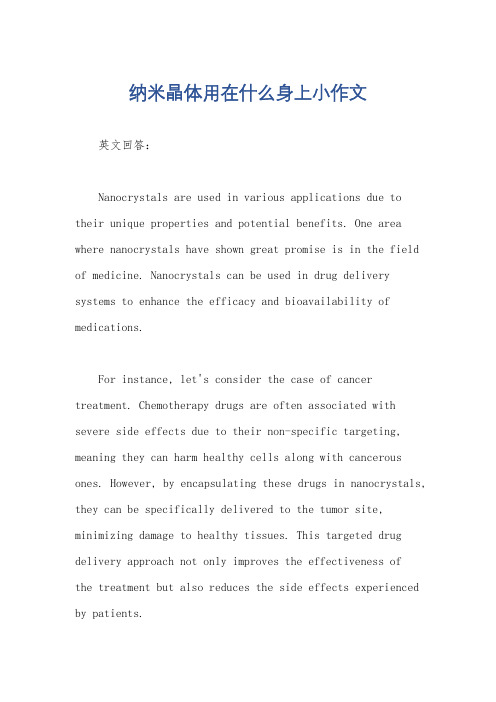
纳米晶体用在什么身上小作文英文回答:Nanocrystals are used in various applications due to their unique properties and potential benefits. One area where nanocrystals have shown great promise is in the field of medicine. Nanocrystals can be used in drug delivery systems to enhance the efficacy and bioavailability of medications.For instance, let's consider the case of cancer treatment. Chemotherapy drugs are often associated with severe side effects due to their non-specific targeting, meaning they can harm healthy cells along with cancerous ones. However, by encapsulating these drugs in nanocrystals, they can be specifically delivered to the tumor site, minimizing damage to healthy tissues. This targeted drug delivery approach not only improves the effectiveness ofthe treatment but also reduces the side effects experienced by patients.In addition to drug delivery, nanocrystals can also be used in medical imaging. For example, quantum dots, which are a type of nanocrystal, have unique optical properties that make them ideal for use in fluorescence imaging. These tiny crystals can emit light of different colors when excited by a specific wavelength of light. By labeling specific molecules or cells with quantum dots, researchers can track their movement and interactions within the body, providing valuable insights into disease progression and treatment response.Furthermore, nanocrystals can be utilized in diagnostic tests. For instance, gold nanocrystals can befunctionalized with specific antibodies to detect the presence of certain biomarkers or pathogens. When these functionalized nanocrystals come into contact with the target molecule, they undergo a change in color or fluorescence, indicating the presence of the target. This allows for rapid and sensitive detection of diseases or infections, facilitating early diagnosis and treatment.中文回答:纳米晶体由于其独特的性质和潜在的优势,在各个领域都有广泛的应用。
纳米金与生物分子的相互作用及生物传感检测
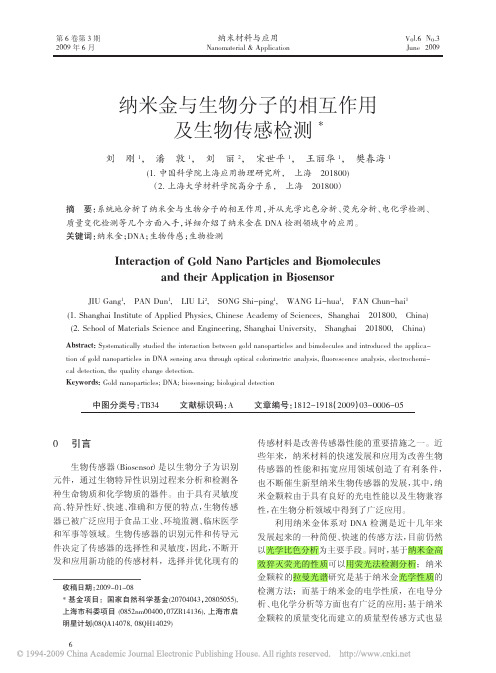
第6卷第3期2009年6月Vol.6No.3June 20090引言生物传感器(Biosensor )是以生物分子为识别元件,通过生物特异性识别过程来分析和检测各种生命物质和化学物质的器件。
由于具有灵敏度高、特异性好、快速、准确和方便的特点,生物传感器已被广泛应用于食品工业、环境监测、临床医学和军事等领域。
生物传感器的识别元件和传导元件决定了传感器的选择性和灵敏度,因此,不断开发和应用新功能的传感材料,选择并优化现有的传感材料是改善传感器性能的重要措施之一。
近些年来,纳米材料的快速发展和应用为改善生物传感器的性能和拓宽应用领域创造了有利条件,也不断催生新型纳米生物传感器的发展,其中,纳米金颗粒由于具有良好的光电性能以及生物兼容性,在生物分析领域中得到了广泛应用。
利用纳米金体系对DNA 检测是近十几年来发展起来的一种简便、快速的传感方法,目前仍然以光学比色分析为主要手段。
同时,基于纳米金高效猝灭荧光的性质可以用荧光法检测分析;纳米金颗粒的拉曼光谱研究是基于纳米金光学性质的检测方法;而基于纳米金的电学性质,在电导分析、电化学分析等方面也有广泛的应用;基于纳米金颗粒的质量变化而建立的质量型传感方式也显收稿日期:2009-01-08*基金项目:国家自然科学基金(20704043,20805055),上海市科委项目(0852nm00400,07ZR14136),上海市启明星计划(08QA14078,08QH14029)纳米金与生物分子的相互作用及生物传感检测*刘刚1,潘敦1,刘丽2,宋世平1,王丽华1,樊春海1(1.中国科学院上海应用物理研究所,上海201800)(2.上海大学材料学院高分子系,上海201800)摘要:系统地分析了纳米金与生物分子的相互作用,并从光学比色分析、荧光分析、电化学检测、质量变化检测等几个方面入手,详细介绍了纳米金在DNA 检测领域中的应用。
关键词:纳米金;DNA ;生物传感;生物检测Interaction of Gold Nano Particles and Biomoleculesand their Application in BiosensorJIU Gang 1,PAN Dun 1,LIU Li 2,SONG Shi-ping 1,WANG Li-hua 1,FAN Chun-hai 1(1.Shanghai Institute of Applied Physics,Chinese Academy of Sciences,Shanghai 201800,China)(2.School of Materials Science and Engineering,Shanghai University,Shanghai 201800,China)Abstract:Systematically studied the interaction between gold nanoparticles and bimolecules and introduced the applica -tion of gold nanoparticles in DNA sensing area through optical colorimetric analysis,fluorescence analysis,electrochemi -cal detection,the quality change detection.Keywords:Gold nanoparticles;DNA;biosensing;biological detection中图分类号:TB34文献标识码:A 文章编号:1812-1918(2009)03-0006-05纳米材料与应用Nanomaterial &Application 6纳米科技Nanoscience &Nanot echnologyNo.3June 2009第6卷第3期2009年6月图1DNA 分子对纳米金颗粒间距的调控及生物传感策略示出较大的潜力。
金纳米簇 金属有机骨架

金纳米簇金属有机骨架English.Gold nanoclusters (Au NCs) are discrete atomically precise subnanometer-sized gold particles with unique physicochemical properties that differ significantly from their bulk counterparts or larger nanoparticles. They have attracted considerable attention due to their intriguing optical, electronic, catalytic, and biological properties, which make them promising candidates for various applications in sensing, catalysis, bioimaging, and theranostics. Metal-organic frameworks (MOFs) are a class of highly porous crystalline materials constructed from inorganic metal ions or clusters coordinated to organic ligands. MOFs have gained significant interest due to their exceptional structural diversity, tunable porosity, and diverse functionalities. The combination of Au NCs and MOFs has emerged as a promising strategy to create multifunctional hybrid materials with synergistic properties.The integration of Au NCs into MOFs offers several advantages. Firstly, Au NCs can serve as active siteswithin the MOFs, enhancing their catalytic activity, electrochemical performance, and sensing capabilities. The small size and high surface area of Au NCs provide abundant active sites for catalytic reactions, while the well-defined structure and composition of Au NCs enable precise control over their catalytic properties. Secondly, Au NCs can enhance the optical properties of MOFs, leading to improved light absorption, emission, and sensing performance. The localized surface plasmon resonance (LSPR) of Au NCs can interact with light, resulting in enhanced light scattering and absorption, which can be exploited for sensing applications. Thirdly, Au NCs can improve the stability and functionality of MOFs. The incorporation of Au NCs into MOFs can enhance their thermal, chemical, and mechanical stability, making them more suitable for practical applications.The synthesis of Au NC@MOF composites can be achieved through various methods, including direct synthesis, post-synthetic modification, and in situ growth. Direct synthesis involves the simultaneous formation of Au NCs and MOFs in a single step, while post-synthetic modification involves the introduction of Au NCs into pre-synthesized MOFs. In situ growth refers to the formation of Au NCs within the pores or on the surface of MOFs during the MOF synthesis process. The choice of synthesis method depends on the desired properties and applications of the resulting Au NC@MOF composites.应用。
不同形状的金纳米粒子的表面增强拉曼光谱
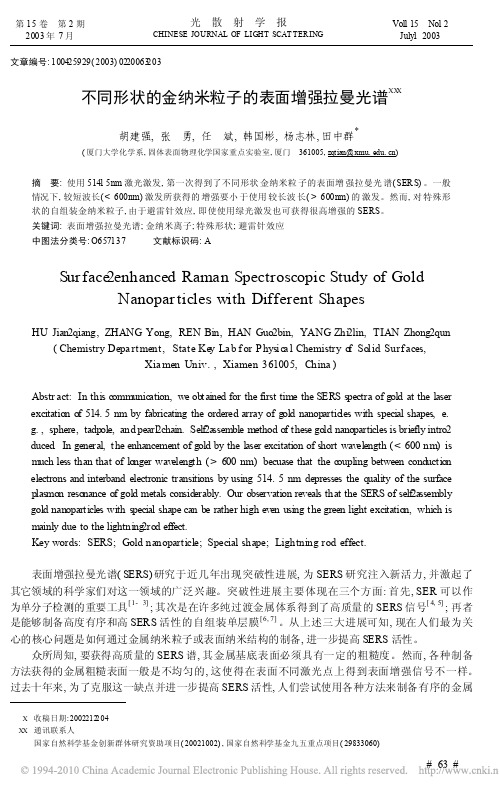
文章编号:100425929(2003)022*******不同形状的金纳米粒子的表面增强拉曼光谱XX X 胡建强,张 勇,任 斌,韩国彬,杨志林,田中群*(厦门大学化学系,固体表面物理化学国家重点实验室,厦门 361005,zqtian@)摘 要:使用51415nm 激光激发,第一次得到了不同形状金纳米粒子的表面增强拉曼光谱(SER S)。
一般情况下,较短波长(<600nm)激发所获得的增强要小于使用较长波长(>600nm)的激发。
然而,对特殊形状的自组装金纳米粒子,由于避雷针效应,即使使用绿光激发也可获得很高增强的SERS 。
关键词:表面增强拉曼光谱;金纳米离子;特殊形状;避雷针效应中图法分类号:O657137 文献标识码:ASurface 2enhanced Raman Spectroscopic Study of GoldNanoparticles with Different ShapesHU Jian 2qiang,ZHANG Yong,REN Bin,HAN Guo 2bin,YANG Zhi 2lin,TIAN Zhong 2qun(Chemistry Depa rtment,State Ke y La b f or Physic a l Chemistry o f Solid Surf aces,Xia men Univ.,Xiamen 361005,China )Abstr act :In this c ommunic ation,we obtained for the first time the SERS spectra of gold at the laserexcitation of 514.5nm by fabricating the ordered array of gold nanopartic les with special shapes, e.g.,sphere,tadpole,and pearl 2chain.Self 2a ssemble method of these gold nanoparticles is briefly intro 2duced.In general,the enhancement of gold by the laser excitation of short wavelength (<600nm)ismuch less than that of longer wavelength (>600nm)becuase that the c oupling between conductionelectrons and interband electronic transitions by using 514.5nm depresses the quality of the surfaceplasmon resonance of gold metals considerably.Our observation reveals that the SERS of self 2a ssemblygold nanoparticles with special shape can be rather high even using the green light excitation,which ismainly due to the lightning 2rod effect.Key words:SERS;Gold nanoparticle;Special shape;Lightning rod effect.表面增强拉曼光谱(SERS)研究于近几年出现突破性进展,为SERS 研究注入新活力,并激起了其它领域的科学家们对这一领域的广泛兴趣。
二氧化硅包覆银纳米三角片的制备方法
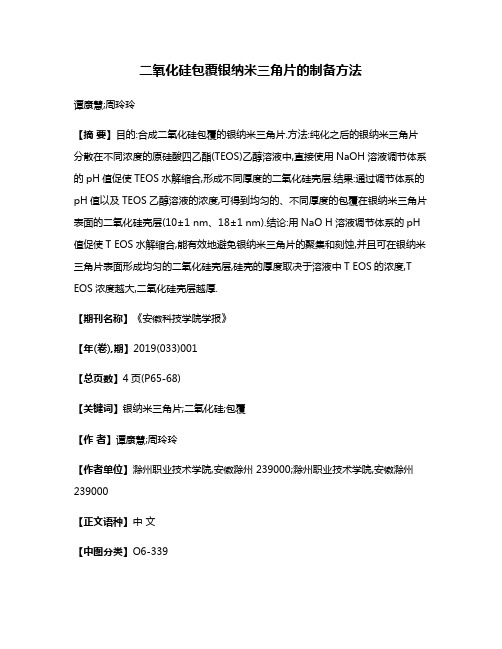
二氧化硅包覆银纳米三角片的制备方法谭康慧;周玲玲【摘要】目的:合成二氧化硅包覆的银纳米三角片.方法:纯化之后的银纳米三角片分散在不同浓度的原硅酸四乙酯(TEOS)乙醇溶液中,直接使用NaOH溶液调节体系的pH值促使TEOS水解缩合,形成不同厚度的二氧化硅壳层.结果:通过调节体系的pH值以及TEOS乙醇溶液的浓度,可得到均匀的、不同厚度的包覆在银纳米三角片表面的二氧化硅壳层(10±1 nm、18±1 nm).结论:用NaO H溶液调节体系的pH 值促使T EOS水解缩合,能有效地避免银纳米三角片的聚集和刻蚀,并且可在银纳米三角片表面形成均匀的二氧化硅壳层,硅壳的厚度取决于溶液中T EOS的浓度,T EOS浓度越大,二氧化硅壳层越厚.【期刊名称】《安徽科技学院学报》【年(卷),期】2019(033)001【总页数】4页(P65-68)【关键词】银纳米三角片;二氧化硅;包覆【作者】谭康慧;周玲玲【作者单位】滁州职业技术学院,安徽滁州 239000;滁州职业技术学院,安徽滁州239000【正文语种】中文【中图分类】O6-339近年来,金属纳米粒子因其在光学、催化、生物传感等领域的广泛应用备受关注,尤其是金、银纳米粒子基于其尺寸[1]、形貌[2-3]的光学性质和独特物理化学性质备受人们青睐。
银纳米三角片因其各向异性的特点,消光系数更大,其吸收光谱能够随着形貌、尺寸的变化发生精细的变化。
但银纳米三角片特殊的结构使其表面具有很高的能量,尤其是三角片的尖端和棱这些银原子容易被氧化的地方,这种氧化会导致三角片的尖端被截断或者溶解,并伴随着表面等离子体共振带的移动或者消失。
正是由于银纳米三角片表面活性高以及不稳定性,使其在组装、检测应用等方面受限,因此通过物理或化学的方法对银纳米三角片表面进行保护以防止银原子氧化是非常必要的。
金属纳米粒子包覆二氧化硅之后不仅可以增加其稳定性,而且可以扩展其表面的功能性质。
纳米技术的作用作文600字
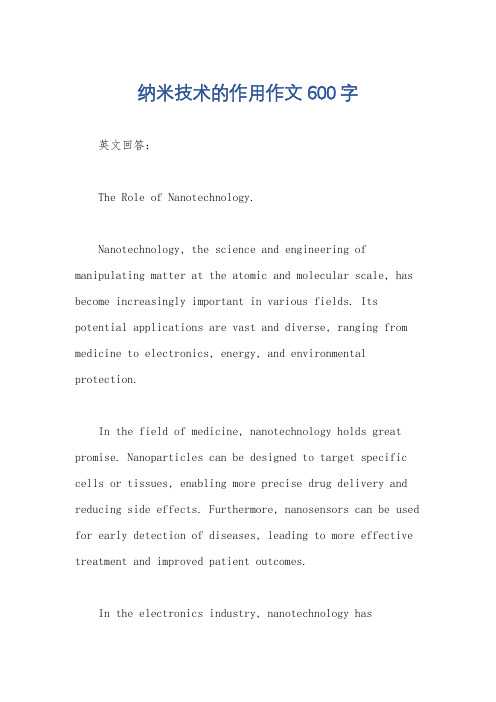
纳米技术的作用作文600字英文回答:The Role of Nanotechnology.Nanotechnology, the science and engineering of manipulating matter at the atomic and molecular scale, has become increasingly important in various fields. Its potential applications are vast and diverse, ranging from medicine to electronics, energy, and environmental protection.In the field of medicine, nanotechnology holds great promise. Nanoparticles can be designed to target specific cells or tissues, enabling more precise drug delivery and reducing side effects. Furthermore, nanosensors can be used for early detection of diseases, leading to more effective treatment and improved patient outcomes.In the electronics industry, nanotechnology hasrevolutionized the development of smaller, faster, and more efficient devices. Nanoscale components allow for greater miniaturization, leading to the production of smaller and more powerful electronic devices such as smartphones and computers. Nanotechnology also plays a crucial role in the development of flexible and wearable electronics, opening up new possibilities for advanced technology integration into our daily lives.Energy is another area where nanotechnology has significant implications. Nanomaterials can enhance the efficiency of solar cells, making them more cost-effective and environmentally friendly. Nanotechnology also enables the development of lightweight and high-capacity batteries, essential for the advancement of electric vehicles and renewable energy storage.In terms of environmental protection, nanotechnology offers innovative solutions. For example, nanomaterials can be used to purify water by removing contaminants and pollutants. Nanoscale catalysts can also be employed to improve the efficiency of industrial processes, reducingwaste and minimizing environmental impact.Overall, nanotechnology has the potential to revolutionize various industries and improve our lives in numerous ways. Its ability to manipulate matter at the atomic and molecular scale opens up new possibilities for advancements in medicine, electronics, energy, and environmental protection.中文回答:纳米技术的作用。
写纳米技术的英语作文一百字以上
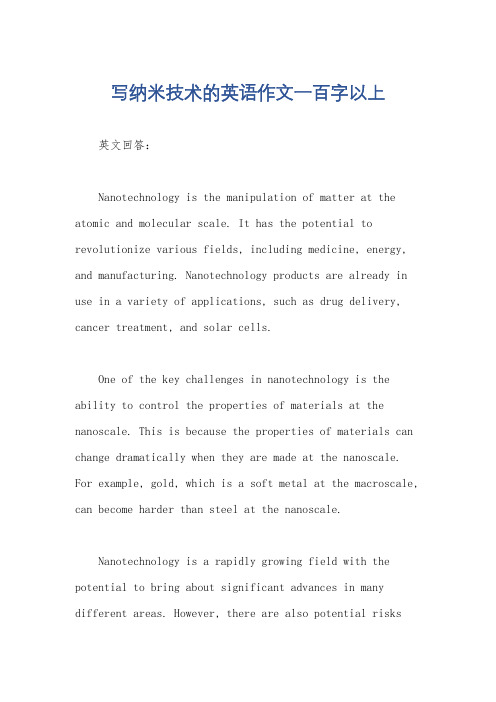
写纳米技术的英语作文一百字以上英文回答:Nanotechnology is the manipulation of matter at the atomic and molecular scale. It has the potential to revolutionize various fields, including medicine, energy, and manufacturing. Nanotechnology products are already in use in a variety of applications, such as drug delivery, cancer treatment, and solar cells.One of the key challenges in nanotechnology is the ability to control the properties of materials at the nanoscale. This is because the properties of materials can change dramatically when they are made at the nanoscale. For example, gold, which is a soft metal at the macroscale, can become harder than steel at the nanoscale.Nanotechnology is a rapidly growing field with the potential to bring about significant advances in many different areas. However, there are also potential risksassociated with nanotechnology, such as the potential for nanomaterials to be toxic to humans and the environment. It is important to carefully consider the potential risks and benefits of nanotechnology before making decisions aboutits use.中文回答:纳米技术是对原子和分子尺度的物质进行操作。
写关于纳米作用的作文
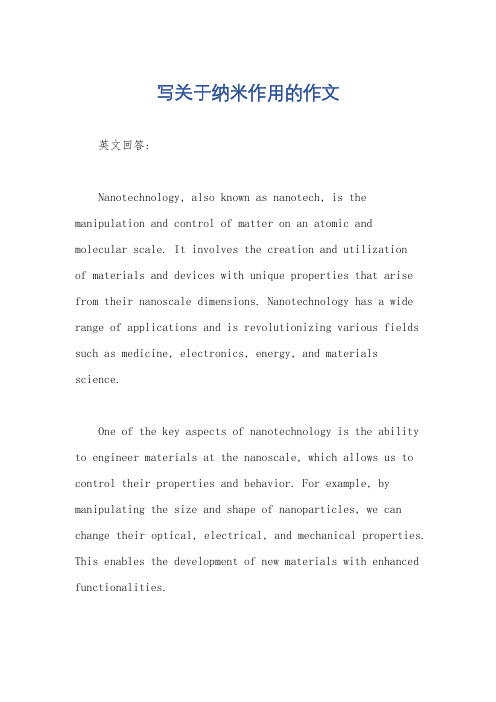
写关于纳米作用的作文英文回答:Nanotechnology, also known as nanotech, is the manipulation and control of matter on an atomic and molecular scale. It involves the creation and utilizationof materials and devices with unique properties that arise from their nanoscale dimensions. Nanotechnology has a wide range of applications and is revolutionizing various fields such as medicine, electronics, energy, and materials science.One of the key aspects of nanotechnology is the ability to engineer materials at the nanoscale, which allows us to control their properties and behavior. For example, by manipulating the size and shape of nanoparticles, we can change their optical, electrical, and mechanical properties. This enables the development of new materials with enhanced functionalities.In medicine, nanotechnology has shown great potentialin drug delivery systems. Nanoparticles can be designed to encapsulate drugs and target specific cells or tissues in the body. This targeted drug delivery approach increases the efficacy of the treatment and reduces side effects. For instance, cancer drugs can be encapsulated in nanoparticles that specifically target cancer cells, minimizing damage to healthy cells.In the field of electronics, nanotechnology has led to the development of smaller, faster, and more efficient devices. Nanoscale transistors have enabled the miniaturization of electronic components, leading to the creation of smaller and more powerful computers and smartphones. Additionally, nanomaterials such as graphene have exceptional electrical conductivity, making them ideal for applications in flexible electronics and wearable devices.Nanotechnology also plays a crucial role in the energy sector. For example, nanomaterials can be used to improve the efficiency of solar cells by enhancing light absorptionand electron transport. Nanotechnology is also being explored for the development of advanced energy storage systems, such as high-capacity batteries and supercapacitors. These advancements in energy technologyare essential for the transition to a more sustainable and clean energy future.中文回答:纳米技术,也被称为纳米科技,是对物质进行原子和分子尺度上的操控和控制。
纳米时代的一天,作文
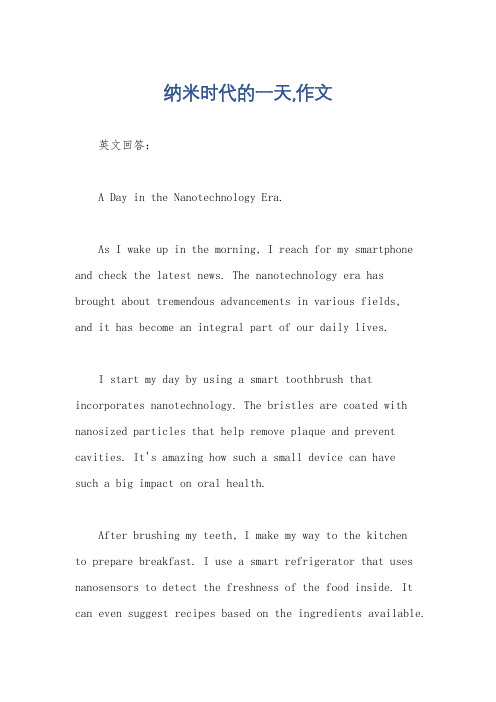
纳米时代的一天,作文英文回答:A Day in the Nanotechnology Era.As I wake up in the morning, I reach for my smartphone and check the latest news. The nanotechnology era has brought about tremendous advancements in various fields,and it has become an integral part of our daily lives.I start my day by using a smart toothbrush that incorporates nanotechnology. The bristles are coated with nanosized particles that help remove plaque and prevent cavities. It's amazing how such a small device can havesuch a big impact on oral health.After brushing my teeth, I make my way to the kitchento prepare breakfast. I use a smart refrigerator that uses nanosensors to detect the freshness of the food inside. It can even suggest recipes based on the ingredients available.Today, it recommends making a nanoburger, a miniaturized version of a regular burger, which is not only delicious but also helps with portion control.As I head out for work, I hop into my self-driving car. Nanotechnology plays a crucial role in the development of autonomous vehicles. Nanosensors and nanochips enable the car to navigate through traffic, detect obstacles, and make split-second decisions to ensure a safe and efficient journey.Arriving at the office, I enter a building equipped with smart windows that use nanomaterials to regulate the temperature and lighting. These windows can automatically adjust their transparency and reflectivity based on the external conditions, providing a comfortable working environment while saving energy.During the day, I use a nanocomputer that fits in the palm of my hand. It's incredibly fast and powerful, thanks to nanoscale transistors and memory chips. This device allows me to multitask efficiently and stay connected withcolleagues and clients.In the evening, I attend a virtual reality concert. The nanotechnology advancements in display technology have made it possible to create immersive and realistic experiences.I feel like I'm standing right next to my favorite artist, enjoying the music and the atmosphere.中文回答:纳米时代的一天。
关于纳米物品的小作文
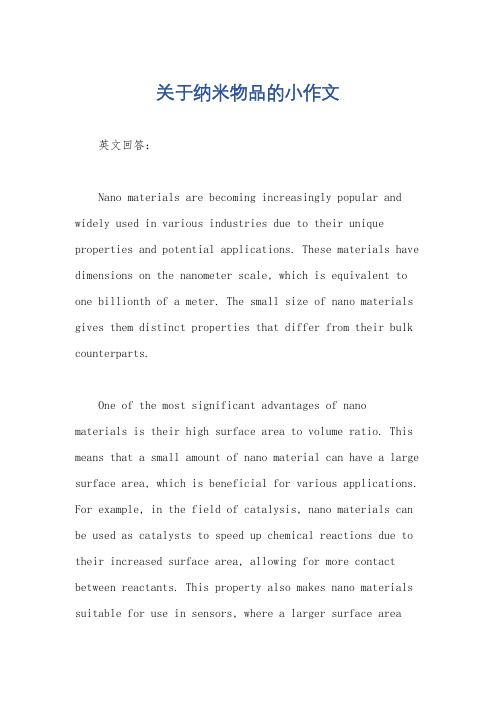
关于纳米物品的小作文英文回答:Nano materials are becoming increasingly popular and widely used in various industries due to their unique properties and potential applications. These materials have dimensions on the nanometer scale, which is equivalent to one billionth of a meter. The small size of nano materials gives them distinct properties that differ from their bulk counterparts.One of the most significant advantages of nano materials is their high surface area to volume ratio. This means that a small amount of nano material can have a large surface area, which is beneficial for various applications. For example, in the field of catalysis, nano materials can be used as catalysts to speed up chemical reactions due to their increased surface area, allowing for more contact between reactants. This property also makes nano materials suitable for use in sensors, where a larger surface areaenhances their sensitivity to detect and respond to changes in the environment.Furthermore, nano materials often exhibit enhanced mechanical, electrical, and optical properties compared to their bulk counterparts. For instance, carbon nanotubes are known for their exceptional strength and electrical conductivity, making them ideal for applications in electronics and aerospace industries. Similarly, nanoparticles of gold or silver can exhibit unique optical properties, such as enhanced absorption or scattering of light, which are utilized in various fields including biomedical imaging and solar energy conversion.In addition to their unique properties, nano materials also offer potential benefits in terms of sustainability and environmental impact. Due to their small size, nano materials can be more efficiently used and distributed, reducing the amount of waste and resources required. For example, nano materials can be incorporated into coatings to improve the durability and performance of products, leading to longer lifespans and reduced need forreplacement. This can contribute to a more sustainable and resource-efficient economy.中文回答:纳米材料由于其独特的性质和潜在应用而在各个行业中越来越受欢迎和广泛使用。
如何写关于纳米的作文
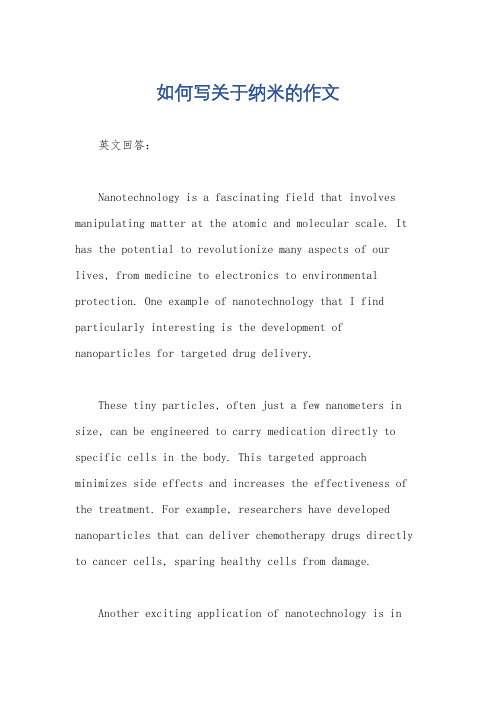
如何写关于纳米的作文英文回答:Nanotechnology is a fascinating field that involves manipulating matter at the atomic and molecular scale. It has the potential to revolutionize many aspects of our lives, from medicine to electronics to environmental protection. One example of nanotechnology that I find particularly interesting is the development of nanoparticles for targeted drug delivery.These tiny particles, often just a few nanometers in size, can be engineered to carry medication directly to specific cells in the body. This targeted approach minimizes side effects and increases the effectiveness of the treatment. For example, researchers have developed nanoparticles that can deliver chemotherapy drugs directly to cancer cells, sparing healthy cells from damage.Another exciting application of nanotechnology is inthe field of electronics. Nanoscale materials can be used to create faster, smaller, and more efficient electronic devices. For instance, nanowires made of materials like silicon or carbon can be used to build ultra-sensitive sensors or high-performance transistors.In addition to these practical applications, nanotechnology also raises ethical and safety concerns. As we continue to develop and use nanomaterials, we must also consider their potential impact on human health and the environment. It is important to conduct thorough research and risk assessments to ensure that nanotechnology is used responsibly.Overall, nanotechnology holds great promise for the future, but it is important to approach its development with caution and consideration for the potential consequences.中文回答:纳米技术是一个令人着迷的领域,涉及在原子和分子尺度上操纵物质。
- 1、下载文档前请自行甄别文档内容的完整性,平台不提供额外的编辑、内容补充、找答案等附加服务。
- 2、"仅部分预览"的文档,不可在线预览部分如存在完整性等问题,可反馈申请退款(可完整预览的文档不适用该条件!)。
- 3、如文档侵犯您的权益,请联系客服反馈,我们会尽快为您处理(人工客服工作时间:9:00-18:30)。
The discovery by Haruta et al of the unexpected low temperature CO oxidation activity of supported gold (1 -4) has opened up a new dimension in the understanding of the basics of catalysis, since gold appears to be an exception in disregarding the requirement of unfilled d-orbitals for a metal catalysed reaction. Gold, in this new incarnation as a catalyst, has already found application in a number of chemical reactions, such as oxidation (of CO, CH4, CH3OH, C6H6, o-hydroxybenzyl alcohol), epoxidation (of propylene), reduction/hydrogenation (of NO, CO, acetylene, butylene), hydrocracking, water gas shift, and isotopic exchange, etc (See recent reviews and publications 5 - 13). Some practical applications of supported gold include: gas sensors (14), regeneration of CO2in sealed-off cw CO2lasers (15, 16) and purification of air (removal of CO and VOC s) (5). In our laboratory, we have developed a compact low-power long-life sealed-off cw CO2laser, where an outer jacket coated with Au/Fe2O3helped in the regeneration of CO2 from the dissociation products CO and O2formed during the laser discharge (15, 16). The performance of this gold catalyst was found to be superior to that of the other noble metals dispersed on reducible oxide supports (such as Pt/SnO2and Pd/SnO2), advocated earlier for this purpose (17). In most of the above-cited applications, the importance of the size of gold crystallites and the nature of the support is generally emphasized. Various issues pertaining to supported gold catalysts, however, still remain unresolved. For instance: what is the role of the gold particle size and what is the optimum size for a particular application? What is the best method of preparing supported gold What oxidation state of gold is vital to its activity? Does an electronic bonding of the reactants occur at gold sites? What is the nature of the transient species formed in the absence and in presence of gold? Unequivocal answers to these questions are yet to be found.
While the requirement of nanosized gold particles is widely accepted, the actual role of gold as a catalyst and also that of its support in the overall performance have, however, raised many divergent views. Various factors contributing to the high activity of these catalysts are。
